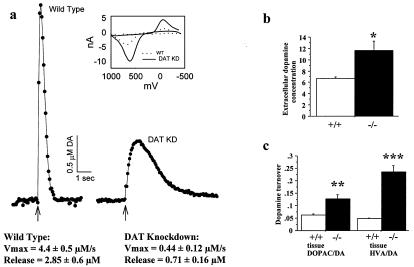Figure 2.
The DAT knockdown mice have a hyperdopaminergic tone. (a) Cyclic voltammetry was used to record dopamine efflux in the striatum (n = 4 for each genotype). Dopamine release was evoked by a single electrical pulse, applied at the time indicated by the arrow. Extracellular dopamine was sampled every 100 ms. The rising portion of the curve represents mainly release, whereas the falling portion represents clearance via the DAT. Release and clearance parameters were obtained by fitting recordings to a Michaelis–Menten-based kinetic model. (Inset) Representative cyclic voltammograms (current/voltage curves). (b) The basal level of extracellular dopamine concentration was measured by quantitative in vivo microdialysis on freely moving animals in their home cages (n = 4 for each genotype). The extracellular dopamine concentration is significantly higher in knockdown than in wild-type mice (t = 3.0, P = 0.02). (c) Total tissue (n = 4 for each genotype) content of dopamine and its metabolites were measured by HPLC-coupled electrochemical detection. DOPAC/dopamine and HVA/dopamine ratios were used as an index of dopamine turnover. Both DOPAC/dopamine (t = 3.7, P = 0.01) and HVA/dopamine (t = 8.0, P = 0.0002) ratios were significantly higher in knockdown than in wild-type mice. Error bar represents SEM.

